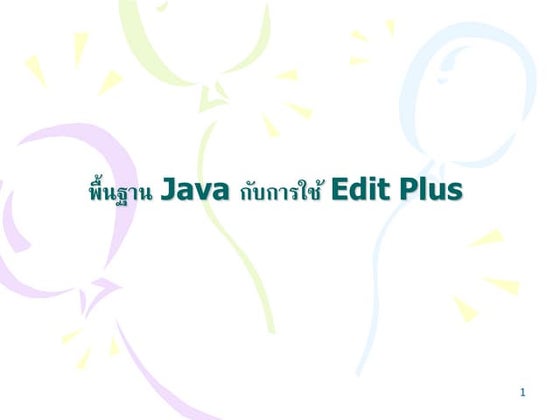02 basic
- 1. āļāļ·āļ āļāļēāļāļāļēāļĢāđāļāļĩāļĒ āļāđāļāļĢāđāļāļĢāļĄ āđ āļāđāļ§ āļĒ C#
- 2. āđāļāļ·āđāļ āļŦāļē ïŽ āđāļāļĢāļāļŠāļĢāđāļēāļāđāļāļĢāđāļāļĢāļĄ ïŽ āļāļāļīāļāļāđāļāļĄāļđāļĨ ïŽ āļāļąāļ§āđāļāļĢ ïŽ āļāļīāļāļāļāđ ïŽ āļāļģāļēāļŠāļąāļāđāļŠāļāļāļāļĨ āđ
- 3. āđāļāļĢāđāļāļĢāļĄāļ āļēāļĐāļē C# ïŽ āļāļīāļāļēāļĢāļāļēāđāļāļĢāđāļāļĢāļĄāļāđāļāđāļāļāļĩāđ namespace HelloW { namespace HelloW { class HelloWClass { class HelloWClass { static void Main () { static void Main () { System.Console.WriteLine("Hello World!"); System.Console.WriteLine("Hello World!"); System.Console.ReadLine(); System.Console.ReadLine(); }} }} }}
- 4. āđāļāļĢāđāļāļĢāļĄāļ āļēāļĐāļē C# ïŽ āļāļąāļ§āļāļąāļāļĐāļĢāđāļĨāđāļ/āđāļŦāļāđāļĄāļĩāļāļ§āļēāļĄāļŠāļģāļēāļāļąāļ ïŽ āļāļģāļēāļŠāļąāļāļāļļāļāļāļģāļēāļŠāļąāļāļāđāļāļāļāļīāļāļāđāļēāļĒāļāđāļ§āļĒ āđ āđ āđāļāļĄāļīāđāļāļĨāļāļ (;) ïŽ āļāļģāļēāļāļ§āļāļāđāļāļāļ§āđāļēāļ (āļāļąāļāđāļāļ§āļāļąāđāļāđāļāļ§āļāļāļ) āđ āđāļĄāđāļĄāļĩāļāļĨāļāđāļāļāļēāļĢāļāļģāļēāļāļēāļ ïŽ āđāļāđāđāļāļĢāļ·āđāļāļāļŦāļĄāļēāļĒāļāļĩāļāļāļē { } āļāļąāļāļāļĨāļļāļĄāļāļģāļēāļŠāļąāļ āđ āđ ïŽ āļāđāļāļāļ§āļēāļĄāļāļĩāļāļĒāļđāđāļĢāļ°āļŦāļ§āđāļēāļ /* * / āļŦāļĢāļ·āļāļŦāļĨāļąāļ // āđ āļāļ·āļāđāļāđāļāļāļāļĄāđāļĄāđāļāļāđ āļāļķāđāļāđāļĄāđāļĄāļāļĨāļāđāļāļāļēāļĢ āļĩ āļāļģāļēāļāļēāļāļāļāļāđāļāļĢāđāļāļĢāļĄ
- 5. āđāļāļĢāļāļŠāļĢāđāļē āļāļāļāļāđāļāļĢāđāļāļĢāļĄ ïŽ āļāļļāļāđāļĢāļīāđāļĄāļāđāļāļāļāļāđāļāļĢāđāļāļĢāļĄāļāļ°āļāļĒāļđāđāļāļĩāđ: static void Main () static void Main () {{ ... starting point ... ... starting point ... }} ï āđāļĢāļĩāļĒāļāļ§āđāļēāđāļĄāļāđāļāļ Main ï āđāļĄāļāđāļāļāļāđāļāļāļāļĒāļđāļ āļēāļĒāđāļāđāļāļĨāļēāļŠ (class) āđ ï āļāļĨāļēāļŠāļāļēāļāļāļĒāļđāđāļ āļēāļĒāđāļāđāđāļāļĄāļŠāđāļāļŠ (namespace) āļŦāļĢāļ·āļāđāļĄāđāļāđāđāļāđ
- 6. āđāļāļĢāļāļŠāļĢāđāļē āļāļāļāļāđāļāļĢāđāļāļĢāļĄ ïŽ āļāļĨāļēāļŠāđāļāļĢāļĩāļĒāļāđāļŠāļĄāļ·āļāļāļāļĨāđāļāļāļāļĢāļĢāļāļļāđāļĄāļāđāļāļ āļŦāļĨāļēāļĒ āđ āđāļĄāļāđāļāļ ïŽ āđāļāļĄāļŠāđāļāļŠāđāļāļĢāļĩāļĒāļāđāļŠāļĄāļ·āļāļāļāļĨāđāļāļāļāļĢāļĢāļāļļāļāļĨāļēāļŠ āļŦāļĨāļēāļĒ āđ āļāļĨāļēāļŠ ï āđāļāļĄāļŠāđāļāļŠāļāļēāļāļāļĒāļđāđāļ āļēāļĒāđāļāđāđāļāļĄāļŠāđāļāļŠāļāļ·āđāļāđāļāđāļāļĩāļ ïŽ āđāļāļĢāđāļāļĢāļĄāļŦāļāļķāđāļ āđ āļāļēāļāļāļĢāļ°āļāļāļāļāđāļ§āļĒāļŦāļĨāļēāļĒ āđāļāļĄāļŠāđāļāļŠ āļŦāļĢāļ·āļāļāļēāļāđāļĄāđāļāļĒāļđāđāļāđāļāļĄāļŠāđāļāļŠāđāļ āđ method1 āđ Class āđāļĨāļĒāļāđāđāļāđ method2 Namespace
- 7. āđāļāļĢāļāļŠāļĢāđāļē āļāļāļāļāđāļāļĢāđāļāļĢāļĄ namespace HelloW { namespace HelloW { class HelloWClass { class HelloWClass { static void Main () { static void Main () { System.Console.WriteLine("Hello World!"); System.Console.WriteLine("Hello World!"); System.Console.ReadLine(); System.Console.ReadLine(); }} }} }} ïŽ āļŠāļģāļēāļŦāļĢāļąāļāđāļāļĢāđāļāļĢāļĄāļāļĒāđāļēāļāļāđāļēāļĒ ï āđāļāļĢāđāļāļĢāļĄāļāļĢāļ°āļāļāļāļāđāļ§āļĒāļāļĨāļēāļŠāđāļāļĩāļĒāļāļāļĨāļēāļŠ āđāļāļĩāļĒāļ§ ï āđāļāļĢāđāļāļĢāļĄāļāļēāļāļāļĢāļ°āļāļāļāļāđāļ§āļĒāđāļĄāļāđāļāļ Main āđāļāļĩāļĒāļāđāļĄāļāđāļāļāđāļāļĩāļĒāļ§
- 8. āļāļģāļē āļŠāļąāđāļ (Statement) ïŽ āļāļģāļēāļŠāļąāļāđāļāđāļāļāļīāļāļēāļĒāļāļēāļĢāļāļģāļēāļāļēāļāļāļāļ āđ āđāļāļĢāđāļāļĢāļĄāđāļāđāļāđāļĨāļ°āļāļąāđāļāļāļāļ Statement#1 class Hello { class Hello { static void Main () { static void Main () { System.Console.WriteLine("Hello World!"); System.Console.WriteLine("Hello World!"); System.Console.ReadLine(); System.Console.ReadLine(); }} }} Statement#2 ïŽ āđāļĄāļāđāļāļāļāļđāļāļŠāļĢāđāļēāļāļāļķāđāļāļāļēāļāļāļģāļēāļŠāļąāļāļāļąāļāđāļāđāļŦāļāļķāļ āđ āđ āđ āļāļķāļāļŦāļĨāļēāļĒāļāļģāļēāļŠāļąāļ āđ
- 9. āļāļģāļē āļŠāļąāđāļ (Statement) namespace HelloW { namespace HelloW { class HelloWClass { class HelloWClass { static void Main () { static void Main () { System.Console.WriteLine("Hello World!"); System.Console.WriteLine("Hello World!"); System.Console.ReadLine(); System.Console.ReadLine(); }} }} }} method1 method2 Class Namespace Statement#1 Statement#2 :
- 10. āļāļēāļĢāļāļąāđāļ āļāļ·āđāļ ïŽ āļāļąāđāļāđāļĄāļāđāļāļ āļāļĨāļēāļŠ āđāļāļĄāļŠāđāļāļŠ āļāđāļāļāļĄāļĩāļāļēāļĢāļāļąāđāļāļāļ·āļ āđ āļāļģāļēāļāļąāļ ïŽ āđāļāļ āļēāļĐāļē C# āļĄāļĩāļāļāļāļēāļĢāļāļąāđāļāļāļ·āļāļāļąāļāļāļĩāđ āđ ï āļāļķāđāļāļāđāļāļāđāļ§āļĒāļāļąāļāļāļĢāļ°āļ āļēāļĐāļēāļāļąāļāļāļĪāļĐ (A-Z, a-z) āļŦāļĢāļ·āļāļāļąāļ§ āļāļĩāļāđāļŠāđāļāđāļāđ (_) ï āļŠāđāļ§āļāļāļĩāđāļŦāļĨāļ·āļāļāļĢāļ°āļāļāļāļāđāļ§āļĒāļāļąāļāļāļĢāļ°āļ āļēāļĐāļēāļāļąāļāļāļĪāļĐ āđ āļāļąāļ§āđāļĨāļ āļŦāļĢāļ·āļāļāļąāļ§āļāļĩāļāđāļŠāđāļāđāļāđ ï āļāļ§āļēāļĄāļĒāļēāļ§āļŠāļđāļāļŠāļļāļ 63 āļāļąāļ§āļāļąāļāļĐāļĢ ï āļāđāļāļāđāļĄāđāļāļģāđāļēāļāļąāļāļāļģāļēāļŠāļāļ§āļ (reserved words) āđāļāđāļ class, namespace ïŽ āļāļąāļ§āļāļĒāđāļēāļāļāļ·āļāļāļĩāđāļāļđāļāļāļ āđ ï hEllO, E3_32ab, X_x_X022 ïŽ āļāļąāļ§āļāļĒāđāļēāļāļāļ·āļāļāļĩāđāļāļīāļāļāļ āđ
- 11. āļāļģāļē āļŠāļāļ§āļ ïŽ āļāļģāļēāđāļŦāļĨāđāļēāļāļĩāđāļŦāļēāļĄāļāļģāļēāđāļāđāļāđāđāļāđāļāļāļ·āļāđāļ āđ āđ āļ āļēāļĐāļē C#
- 12. āļāļąāļ§ āđāļāļĢ (Variable) ïŽ āļāļąāļ§āđāļāļĢāđāļāđāļŠāļģāļēāļŦāļĢāļąāļāđāļāđāļāļāđāļēāļāļāļāļāđāļāļĄāļđāļĨ ïŽ āļāļēāļĢāļāļĢāļ°āļāļēāļĻāļāļąāļ§āđāļāļĢ <data type> <variable name>; <data type> <variable name>; ïŽ āļāļēāļĢāļāļģāļēāļŦāļāļāļāđāļēāđāļŦāđāļāļąāļ§āđāļāļĢ <name> = <expression>; <name> = <expression>; ïŽ āļāļąāļ§āļāļĒāđāļēāļ int width, height; int width, height; int area; int area; width = 10; height = 20; width = 10; height = 20; area = width * height; area = width * height;
- 13. āļāļāļīāļ āļāđāļ āļĄāļđāļĨ (Data Type) āļāļāļīāļ āļāļāļēāļ āļāļ§āļēāļĄāļŦāļĄāļēāļĒ āļāđāļ§ āļ bool 1 byte āļāđāļēāļāļ§āļēāļĄāļāļĢāļīāļ (āļāļĢāļīāļ-āđāļāđāļ) true / false char 2 byte āļāļąāļāļāļĢāļ°āđāļāļ character code 0...65535 sbyte 1 byte āļāļģāļēāļāļ§āļāđāļāđāļĄ -128...127 byte 1 byte āļāļģāļēāļāļ§āļāđāļāđāļĄāđāļĄāđāļāļīāļāļĨāļ 0...255 short 2 bytes āļāļģāļēāļāļ§āļāđāļāđāļĄ -32,768...32,767 ushort 2 bytes āļāļģāļēāļāļ§āļāđāļāđāļĄāđāļĄāđāļāļīāļāļĨāļ 0...65535 int 4 bytes āļāļģāļēāļāļ§āļāđāļāđāļĄ -2.1 x 109...2.1 x 109 uint 4 bytes āļāļģāļēāļāļ§āļāđāļāđāļĄāđāļĄāđāļāļīāļāļĨāļ 0...4.3 x 109 long 8 bytes āļāļģāļēāļāļ§āļāđāļāđāļĄ -9.2 x 1018...9.2 x 1018 ulong 8 bytes āļāļģāļēāļāļ§āļāđāļāđāļĄāđāļĄāđāļāļīāļāļĨāļ 0...1.8 x 1019 float 4 bytes āļāļģāļēāļāļ§āļāļāļĢāļīāļ Âą1.5x10-45...Âą3.4x1038 double 8 bytes āļāļģāļēāļāļ§āļāļāļĢāļīāļāļāļ§āļēāļĄāļĨāļ°āđāļāļĩāļĒāļāļŠāļāļāđāļāđāļē Âą5.0x10-324...Âą1.7x10308 decimal 16 bytes āļāļģāļēāļāļ§āļāļāļĢāļīāļāļāļ§āļēāļĄāļĨāļ°āđāļāļĩāļĒāļāļŠāļđāļ Âą1.0x10--28...Âą7.9x1028 string N/A āļŠāļēāļĒāļāļąāļāļāļĢāļ° N/A
- 14. āļāļēāļĢāļāļģāļē āļŦāļāļāļāđāļē āđāļŦāđāļ āļąāļ§ āđāļāļĢ ïŽ āđāļĢāļēāļŠāļēāļĄāļēāļĢāļāļāļģāļēāļŦāļāļāļāđāļēāđāļĢāļīāđāļĄāļāđāļāđāļŦāđāļāļąāļ āļāļąāļ§āđāļāļĢāđāļāđāļāļĢāđāļāļĄāļāļąāļāļāļēāļĢāļāļĢāļ°āļāļēāļĻ āļāļąāļ§āđāļāļĢāļāļąāļ āđ āđāļāđāļāļāļāļĩ āđ āļą ïŽ āļāļąāļ§āļāļĒāđāļēāļ int width = 10, height = 20; int width = 10, height = 20; int area; int area; area = width * height; area = width * height;
- 15. āļāļīāļ āļāļāđ (Expressions) ïŽ āļāļīāļ āļāļāđāđāļāđāļāļŠāđāļ§āļāļŦāļāļķāđāļāļāļāļāļāļģāļēāļŠāļąāļāļāļĩāđāļāļ āđāļāđ āđ āļđ āļāļĢāļ°āđāļĄāļīāļāđāļāđāļāļāđāļēāđāļāđ ï āļāļēāļāđāļāđāļāļāđāļēāđāļāļāļŦāļĢāļ·āļāļāļĢāļ°āļāļāļāļāļķāđāļāļĄāļēāļāļēāļ āļāļīāļāļāļāđāļāļĩāđāđāļĨāđāļāļāļ§āđāļē ïŽ āļāļąāļ§āļāļĒāđāļēāļāļāļāļāļāļīāļāļāļāđāļāđāļāđāļāļāđāļēāđāļāļ āļĩāđ ï āļāļąāļ§āđāļĨāļ ïĻ , 3.1415 3212 ï āļāļąāļāļāļĢāļ° ïĻ'C' ï āļāđāļēāļāļ§āļēāļĄāļāļĢāļīāļ ïĻ true or false ï āļāđāļāļāļ§āļēāļĄ ïĻ "Hello, World" ï āļāļąāļ§āđāļāļĢāļŦāļĢāļ·āļāļāđāļēāļāļāļāļĩāđ ïĻ , myName x
- 16. āļāļīāļ āļāļāđāļ āļēāļāļāļāļīāļ āļĻāļēāļŠāļāļĢāđ ïŽ āļāļīāļāļāļāđāļāļēāļāļāļāļīāļāļĻāļēāļŠāļāļĢāđ (arithmetic expression) āļāļ·āļāļāļīāļāļāļāđāļāļĩāđāļāļđāļāļāļĩāļāļ§āļēāļĄāđāļāđāļāļāđāļēāļāļģāļēāļāļ§āļ ïŽ āļāļīāļāļāļāđāļāļēāļāļāļāļīāļāļĻāļēāļŠāļāļĢāđāļŠāļēāļĄāļēāļĢāļāļāļģāļēāļĄāļēāļāļĢāļ°āļāļāļ āđāļāđāļāļāļīāļāļāļāđāļāļĩāđāļāļąāļāļāđāļāļāļāļķāđāļāđāļāđāđāļāļĒāļāļēāļĻāļąāļĒāļāļąāļ§āļāļģāļēāđāļāļīāļ āļāļēāļĢāļāļēāļāļāļāļīāļāļĻāļēāļŠāļāļĢāđ (arithmetic operators) ï +, -, *, / ï % (āđāļŦāđāļāđāļēāđāļĻāļĐāļāļēāļāļāļēāļĢāļŦāļēāļĢ) ïŽ āļāļąāļ§āļāļĒāđāļēāļ ï 11+5 ïĻ 16 ï 11/2 ïĻ5 ï 11.0/2 ïĻ 5.5 ï 11%2 ïĻ1 ï 5.0%2.2 ïĻ 0.6
- 17. āļĨāļģāļē āļāļąāļ āļāļēāļĢāļāļģāļē āļāļ§āļ (P recedence Rules) 1. () 2. *, / , % 3. +, â 4. āļāđāļēāļĒāđāļāļāļ§āļē int Width,Height; Width = 10*5+(16 * 12)/5; Height = (16+5)+20%2;
- 18. āļāļēāļĢāļŦāļēāļĢāđāļāļāļāļģāļē āļāļ§āļāđāļāđāļĄ ïŽ āļāļēāļĢāļŦāļēāļĢāļāļīāļāļāļāđāļāļĩāđāđāļāđāļāļāļģāļēāļāļ§āļāđāļāđāļĄāļŠāļāļ āļāļģāļēāļāļ§āļāđāļŦāđāļāļĨāļĨāļąāļāļāđāđāļāđāļāļāļģāļēāļāļ§āļāđāļāđāļĄāđāļŠāļĄāļ ï āđāļĻāļĐāļāļ°āļāļđāļāļāļąāļāļāļīāđāļ ïŽ āļŦāļēāļāļāļąāļ§āļāļąāđāļāđāļĨāļ°/āļŦāļĢāļ·āļāļāļąāļ§āļŦāļēāļĢāđāļāđāļāļāļģāļēāļāļ§āļ āļāļĻāļāļīāļĒāļĄ (float āļŦāļĢāļ·āļ double) āļāļēāļĢāļŦāļēāļĢāļāļ° āļāļģintāļāļ§āļāļāļĻāļāļīāļĒ=āļĄāđāļŦāđ āļē i1 == 10, i2 == 8; int i1 10, i2 8; double f1 = 10, f2 = 8; double f1 = 10, f2 8; double r1 = i1/i2; double r1 = i1/i2; // r1 = 1 // r1 = 1 double r2 = f1/f2; double r2 = f1/f2; // r2 = 1.25 // r2 = 1.25 double r3 = f1/i2; double r3 = f1/i2; // r3 = 1.25 // r3 = 1.25 double r4 = i1/f2; double r4 = i1/f2; // r4 = 1.25 // r4 = 1.25 double r1 = 10/8; double r1 = 10/8; // r1 = 1 // r1 = 1 double r2 = 10.0/8.0; double r2 = 10.0/8.0; // r2 = 1.25 // r2 = 1.25 double r3 = 10.0/8; double r3 = 10.0/8; // r3 = 1.25 // r3 = 1.25 double r4 = 10/8.0; double r4 = 10/8.0; // r4 = 1.25 // r4 = 1.25
- 19. āļāļģāļē āļŠāļąāđāļ using ïŽ āļāļēāļĢāđāļāđāļāļģāļēāļŠāļąāđāļ using <āļāļ·āđāļāđāļāļĄāļŠāđāļāļŠ> āļāļĩāđāļāđāļ āđāļāļĢāđāļāļĢāļĄāđāļāđāļāļāļēāļĢāļĢāļ°āļāļļāļ§āđāļēāđāļĢāļēāļāđāļāļāļāļēāļĢāđāļĢāļĩāļĒāļ āđāļāđāļāļēāļāļāļĨāļēāļŠāđāļāđāļāļĄāļŠāđāļāļŠāļāļąāđāļ āđ ïŽ āļāļąāļ§āļāļĒāđāļēāļ: āļāļĨāļēāļŠ Console āļāļĒāļđāđāđāļāđāļāļĄāļŠāđāļāļŠ class Hello {{ class Hello System static void Main () {{ static void Main () System.Console.WriteLine("Hello World!"); System.Console.WriteLine("Hello World!"); System.Console.ReadLine(); System.Console.ReadLine(); }} }} using System; using System; class Hello {{ class Hello static void Main () {{ static void Main () Console.WriteLine("Hello World!"); Console.WriteLine("Hello World!"); Console.ReadLine(); Console.ReadLine(); }} }}
- 20. āļāļģāļē āļŠāļąāđāļ āļŠāļģāļē āļŦāļĢāļąāļ āđāļŠāļāļāļāļĨāļāļēāļ āļŦāļāđāļēāļģāļēāļāļ āļŦāļĢāļ·āļ WriteLine āļāļķāđāļāļāļĒāļđāđāđāļāļāļĨāļēāļŠ ïŽ āđāļāđāļ āļŠāļąāđāļ Write Console (āļāļķāđāļāļāļĒāļđāđāđāļāđāļāļĄāļŠāđāļāļŠ System āļāļĩāļāļāļĩāļŦāļāļķāļ) āđ ïŽ āļāļēāļĢāđāļāđāļāļēāļāļāļ·āđāļāļāļēāļ: Console.WriteLine("Hello"); Console.WriteLine("Hello"); Console.WriteLine(area); Console.WriteLine(area); ïŽ āļāļēāļĢāđāļāđāļāļēāļāļāļąāļāļŠāļđāļ: āđ Console.WriteLine(âSize {0}x{1}â, width, height); Console.WriteLine(âSize {0}x{1}â, width, height); double salary=12000; double salary=12000; Console.WriteLine("My salary is {0:f2}.", salary); Console.WriteLine("My salary is {0:f2}.", salary);
































![Java Programming [12/12] : Thread](https://cdn.slidesharecdn.com/ss_thumbnails/chapter12-130103210519-phpapp02-thumbnail.jpg?width=560&fit=bounds)























































